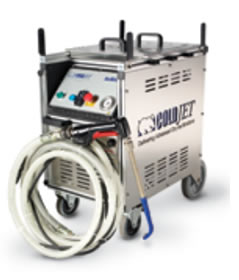Dry Ice (CO2) Blasting
Use Dry Ice Blasting For:
Black Mold Remediation & Fire Restoration Cleanup
Black mold and soot from fires cleans up easily with dry ice blasting. Remediation time is also quicker—with work completed in days, not weeks.
Electrical Component Cleaning
National Vacuum commonly uses dry ice blasting for cleaning electrical contacts and electronic components in dusty and grimy environments. Dry ice eliminates the need to use water or corrosive solvents that can lead to costly problems down the road.
Graffiti Removal & Restoration

Unlike sandblasting, CO2 blasting does not etch surfaces or leave piles of extra material to dispose of. As the carbon dioxide pellets strike a surface, they instantly change from a solid to a harmless gas that does not leave any residue or liquid behind.
Lead & Oil Surface Cleaning
Lead paint can also be removed using CO2 blasting. As the paint is blasted away, the only mess remaining is the paint chips that are blasted off. Oily surfaces are almost magically cleaned as the oil is instantly frozen and blasted off, leaving virtually no residue.
Advantages of Dry Ice Blasting:
Reduction in contaminants and waste.
The only contaminant produced is the material that is removed from the blasting process.
Safe for the environment.
CO2 is a harmless gas contained in the air we breathe. No solvents or hazardous silica are used.
Safe on machinery and surfaces.
Dry ice blasting is a non-abrasive form of cleaning and will not etch surfaces.
Safe for employees.
Since CO2 is a non-hazardous material, PPE requirements for blasting personnel is minimal (which also keeps cost down), creating a safe work environment for plant personnel.
Unparalleled coverage.
CO2 blasting provides better access to attics, roofs, crawl spaces, and tight areas where typical cleaning applications are not possible. It also penetrates behind and between structural members to deliver supreme coverage.
Fast.
Dry ice blasting is extremely quick compared to other cleaning methods (approximately five-square feet per minute)—getting machinery or equipment on-line quicker and shortening down time.
